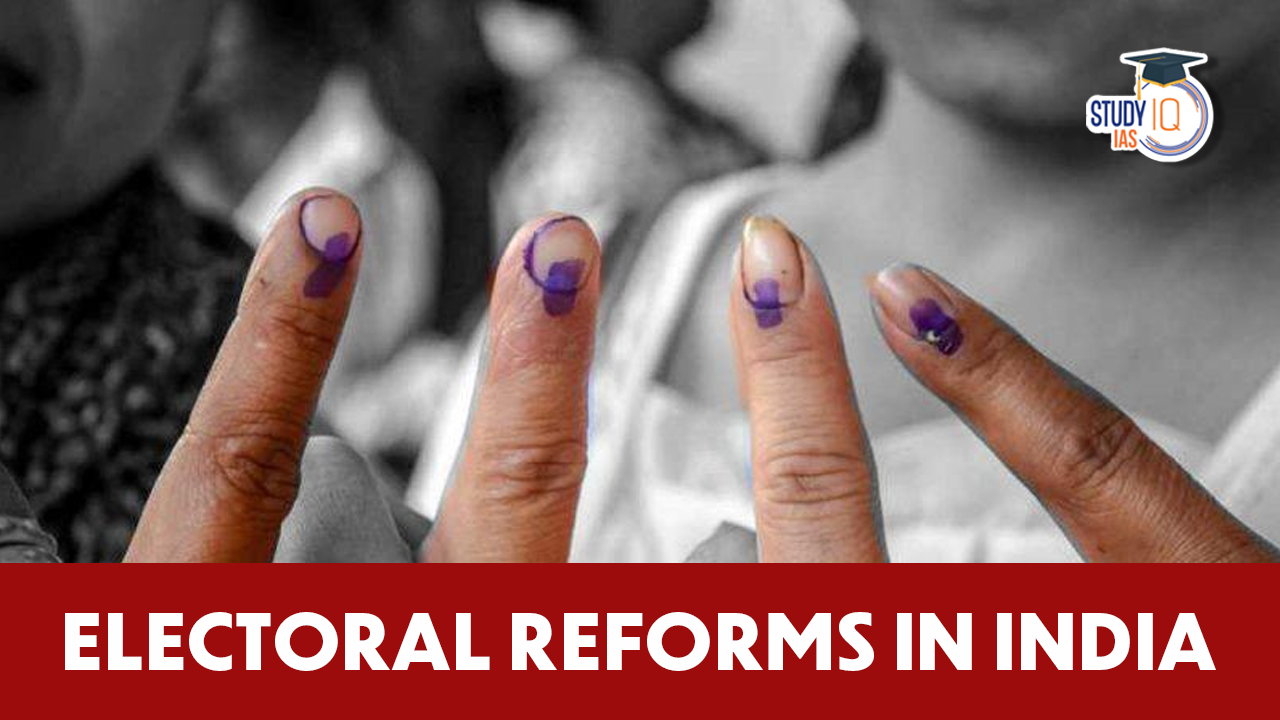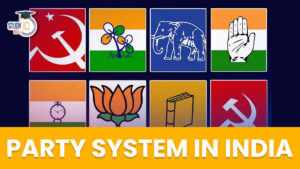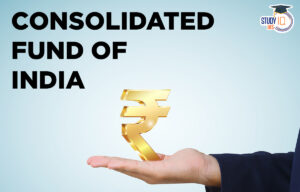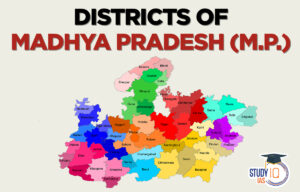Table of Contents
Context: The Election Commission (EC) has invited political parties to discuss strengthening the election process.
More in News
This follows allegations of electoral roll manipulation during the recent assembly elections and concerns over duplicate Electoral Photo Identity Card (EPIC) numbers across different States.
Electoral Reforms in India
In India, the term “electoral reforms in India” refers to the evolution and modification of the electoral system. The Electoral Reforms seek to promote clean politics, free and fair elections, and ideal legislators. It contributes to making Indian democracy a true democracy in both letter and spirit. The Indian Constitution’s Articles 324 to 329 cover elections and the electoral process. Elections in India are now significantly safer for candidates and voters thanks to election reforms. Additionally, it has regulated the electoral process to eradicate election-related fraud.
Electoral Reforms in India Background
Electoral reforms in India have been an ongoing process aimed at improving the electoral system’s fairness, transparency, and effectiveness. The need for such reforms arises from various challenges and issues faced by the electoral process, including corruption, malpractice, and inequality. Understanding the background of electoral reforms in India requires examining historical developments and the evolution of the electoral system.
| Evolution | Description |
|---|---|
| Pre-Independence Era | Limited and undemocratic electoral system under British colonial rule. |
| Constitutional Framework | Establishment of electoral framework in the Constitution of India (1950). |
| Early Electoral Practices | Initial elections are supervised by the Election Commission of India (ECI). |
| Emergence of Electoral Issues | Challenges such as corruption, criminalization of politics, and voter intimidation begin to surface. |
| Initiatives for Reform | Establishment of expert committees, legislative amendments, and administrative measures. |
| Landmark Reforms | Introduction of significant reforms addressing campaign finance, electoral administration, and voter registration. |
| Role of the Election Commission | ECI’s pivotal role in overseeing elections, enforcing laws, and promoting voter education. |
| Legal Framework | Amendments to electoral laws aimed at strengthening enforcement and enhancing credibility. |
| Public Discourse and Civil Society Engagement | Active involvement of civil society, media, and activists in advocating for reforms and raising awareness. |
Legal Framework for Elections
- Article 324 of the Constitution: Empowers the EC with the superintendence, direction, and control over the preparation of electoral rolls and the conduct of elections to Parliament and State legislatures.
- Governing Laws: The preparation of electoral rolls is regulated by:
- Representation of the People Act, 1950
- Registration of Electors Rules, 1960
Evolution of the Voting Process
- First Two General Elections (1952, 1957): Separate ballot boxes for each candidate with their election symbol were used.
- Voters dropped a blank ballot paper into the box of their chosen candidate.
- Introduction of Ballot Papers (1962): From the third general election, ballot papers with names and symbols of candidates were introduced.
- Use of Electronic Voting Machines (EVMs) (2004): EVMs have been used in all constituencies since the 2004 Lok Sabha elections.
- Introduction of VVPAT (2019): Since 2019, EVMs have been backed by 100% Voter Verifiable Paper Audit Trail (VVPAT) slips in all constituencies.
Issues in the Electoral Process
Issues in the Voting and Counting Process
- Demand for Paper Ballots: A PIL sought a return to paper ballots, which the Supreme Court dismissed in April 2024.
- VVPAT and EVM Matching: The demand for 100% matching of VVPAT slips with EVM count (currently done for five machines per assembly segment) was rejected.
- Supreme Court allowed the burnt memory of 5% of EVMs to be checked by EVM manufacturers’ engineers if suspected tampering is reported by second or third-placed candidates within seven days of result declaration.
- Allegations of Electoral Roll Manipulation: Allegations of bogus voter additions in Maharashtra and Delhi Assembly elections to benefit the ruling party.
- Duplicate EPIC Numbers: Identical EPIC numbers are found in different States like West Bengal, Gujarat, Haryana, and Punjab.
- Result of a previously decentralised EPIC number system before shifting to the ERONET platform.
- EC clarified that voters can only vote in their designated polling station.
Issues in the Campaign Process
- Misuse of Star Campaigner Status: Leaders using abusive language, appealing to caste/communal sentiments, and making unsubstantiated allegations.
- Election Expenditure Violations:
- Widespread breach of expenditure limits by candidates.
- No limit on political party spending during elections.
- Estimated election expenditure in 2024 Lok Sabha elections: ₹1,00,000 crore.
- High spending fuels corruption and creates a vicious cycle.
- Criminalisation of Politics:
- 251 (46%) of the 543 elected MPs in 2024 have criminal cases.
- 170 (31%) MPs face serious charges like rape, murder, and kidnapping.
Required Electoral Reforms
Reforms in Voting and Counting Process
- Scientific Sampling of VVPAT Verification: Sample size for EVM and VVPAT matching should be scientifically determined.
- Full VVPAT counting should be done if a single error is detected.
- Introduction of Totaliser Machines: Aggregates votes in 14 EVMs before revealing the candidate-wise count.
- Recommended by EC in 2016 to protect voter secrecy at the booth level.
- Verification of 5% of EVMs: Second and third-placed candidates should request verification of 5% of EVMs in case of tampering suspicions.
- Unique EPIC Numbers and Aadhaar Linking: EC should remove duplicate EPIC numbers across States.
- Aadhaar linking with EPIC may be considered after addressing privacy concerns.
Reforms in Campaign Process
- Strict Action Against Star Campaigner Misconduct: EC should revoke ‘Star Campaigner’ status for serious MCC violations.
- EC can suspend or withdraw party recognition for violating MCC which is under Paragraph 16A of the Symbols Order.
- Election Expenditure Regulation: Election expenditure by political parties should have a
- Financial assistance by parties to candidates should be counted within the expenditure limit.
- Disclosure of Criminal Antecedents: Candidates and parties must disclose criminal records three times before the election.
- Must be published in a widely circulated local newspaper and electronic media.
Institutional Reforms
- Constructive Dialogue: EC and political parties should engage in meaningful discussions to improve electoral and campaign processes.
- The objective is to build public confidence in free and fair elections.
Major Challenges in Electoral Reforms in India
- Money Power: Campaigning for elections is an expensive process in any democracy, but it is particularly so in India. Money power has a detrimental effect on our electoral system, seriously impairing how regularly scheduled elections operate. It causes widespread corruption and plays a significant role in the black money industry.
- Muscle Power: The results of physical power include silent and merciless booth capturing, most types of rigging, victimisation following an election, and pre-and post-election intimidation.
- Politics being criminalised: The criminalization of politics and the criminalization of criminals, both of which are now openly practised, are two sides of the same coin and are principally to blame for the show of savagery at elections. Through the use of violence, criminals can win elections for their supporters.
- Misuse of Government Machinery: It is a prevalent belief that the government in power at the time of an election will utilise improper means to promote the electoral success of members of its own party. Misuse of government resources can take many different forms, such as spending ministerial discretionary funds on personal expenses, using government vehicles for canvassing, and publishing advertisements at the expense of the government and the public exchequer to highlight their achievements.
- Casteism: In some instances, specific caste groups have shown fervent support for specific political parties. As a result, political parties make concessions to appeal to various castes, and castes also attempt to pressure parties into providing tickets for the elections of their members. Caste voting is very common in the nation, which is a significant blemish on democracy and equality. Additionally, this causes rifts throughout the nation.
- Communalism: The political ethos of pluralism, parliamentarians, secularism, and federalism in India is seriously threatened by communal polarization. Find out more about communalism in the article that is linked.
- Absence of Moral Principles in Politics: Politics in India has turned into a business as a result of political corruption. People get involved in politics to increase their wealth and influence. There aren’t many politicians who want to improve the lot of their constituents. The Gandhian principles of sacrifice and service are absent from India’s political landscape.


 Party System in India, Feature, Importan...
Party System in India, Feature, Importan...
 Consolidated Fund of India, Meaning and ...
Consolidated Fund of India, Meaning and ...
 Districts of MP List, Name, Importance, ...
Districts of MP List, Name, Importance, ...





















